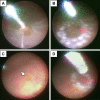Clinical outcomes of endoscope-assisted vitrectomy for treatment of rhegmatogenous retinal detachment
- PMID: 29180845
- PMCID: PMC5694206
- DOI: 10.2147/OPTH.S147690
Clinical outcomes of endoscope-assisted vitrectomy for treatment of rhegmatogenous retinal detachment
Abstract
Summary: We evaluated the clinical outcomes for ophthalmic endoscope-assisted vitrectomy in consecutive patients with uncomplicated rhegmatogenous retinal detachment (RRD). The primary success rate was 98.4% (125/127) without performing a posterior drainage retinotomy or using perfluorocarbon liquids (PFCL) for subretinal fluid drainage.
Purpose: To investigate the clinical outcomes of endoscope-assisted vitrectomy in patients with uncomplicated RRD.
Methods: We examined 127 eyes from consecutive patients who underwent repair of RRD by 23- or 25-gauge endoscope-assisted vitrectomy, with a minimum follow-up of 3 months. Eyes with the following criteria were excluded: Giant retinal tears, grade C proliferative vitreoretinopathy, dense vitreous hemorrhage, retinal detachment secondary to other ocular diseases, and prior retinal or vitreous surgery. All cases underwent subretinal fluid drainage, endolaser photocoagulation and fundus inspection were performed under ophthalmic endoscopic observation. Success rate, visual acuity, surgery time and complications were evaluated.
Results: Primary and final success rate was 98.4% (125/127) and 100% (127/127), respectively, Surgery time was 59.6±26.3 minutes. The best-corrected visual acuity significantly improved from 20/100 to 20/20 (P<0.0001). There were 2 cases (1.6%) of creation of a peripheral drainage retinotomy and 4 cases (3.1%) of using PFCL to suppress movement of the detached retina, but there were no cases of creation of a posterior drainage retinotomy or using PFCL for subretinal fluid drainage. There was 1 case of presumed endophthalmitis after surgery. There were 12 hypotonous cases at postoperative day 1 and one of them needed additional scleral sutures at postoperative day 4 for prolonged hypotony.
Conclusion: The present study demonstrated the efficacy of endoscope-assisted vitrectomy for patients with uncomplicated RRD. To perform endoscope-assisted vitrectomy safely, sufficient closure of sclerotomies is necessary at the end of surgery.
Keywords: endoscope-assisted vitrectomy; endoscopic vitrectomy; ophthalmic endoscope; retinal detachment; rhegmatogenous retinal detachment.
Conflict of interest statement
Disclosure The authors report no conflicts of interest in this work.
Figures


Similar articles
-
Clinical Outcomes of Endoscope-Assisted Vitreous Surgery for Giant Retinal Tear Detachment.Ophthalmic Res. 2021;64(5):820-827. doi: 10.1159/000517353. Epub 2021 Jun 1. Ophthalmic Res. 2021. PMID: 34062537
-
Efficacy and Safety of Vitrectomy without Using Perfluorocarbon Liquids and Drainage Retinotomy Associated with Postoperative Positioning Based on Residual Subretinal Fluid for Rhegmatogenous Retinal Detachment.J Ophthalmol. 2021 Apr 20;2021:5588479. doi: 10.1155/2021/5588479. eCollection 2021. J Ophthalmol. 2021. PMID: 33996150 Free PMC article.
-
Subretinal fluid drainage via original retinal breaks for rhegmatogenous retinal detachment.Can J Ophthalmol. 2014 Jun;49(3):256-60. doi: 10.1016/j.jcjo.2014.03.001. Can J Ophthalmol. 2014. PMID: 24862771
-
Prevention of rhegmatogenous retinal detachment.Surv Ophthalmol. 2025 May 6:S0039-6257(25)00071-2. doi: 10.1016/j.survophthal.2025.04.006. Online ahead of print. Surv Ophthalmol. 2025. PMID: 40339663 Review.
-
Retinal displacement following repair of rhegmatogenous retinal detachment.Oman J Ophthalmol. 2023 Jun 27;16(2):205-210. doi: 10.4103/ojo.ojo_187_22. eCollection 2023 May-Aug. Oman J Ophthalmol. 2023. PMID: 37602174 Free PMC article. Review.
Cited by
-
Translational Retinal Imaging.Asia Pac J Ophthalmol (Phila). 2020 May-Jun;9(3):269-277. doi: 10.1097/APO.0000000000000292. Asia Pac J Ophthalmol (Phila). 2020. PMID: 32487917 Free PMC article. Review.
-
Endoscopy-assisted vitrectomy vs. vitrectomy alone: comparative study in complex retinal detachment with proliferative vitreoretinopathy.Int J Retina Vitreous. 2020 Jul 29;6:34. doi: 10.1186/s40942-020-00238-9. eCollection 2020. Int J Retina Vitreous. 2020. PMID: 32742720 Free PMC article.
-
Intraocular endoscopy: A review.Indian J Ophthalmol. 2021 Jan;69(1):14-25. doi: 10.4103/ijo.IJO_1029_20. Indian J Ophthalmol. 2021. PMID: 33323565 Free PMC article. Review.
-
Factors associated with postoperative visual function after rhegmatogenous retinal detachment with foveal detachment.PLoS One. 2024 Sep 20;19(9):e0308863. doi: 10.1371/journal.pone.0308863. eCollection 2024. PLoS One. 2024. PMID: 39302973 Free PMC article.
References
-
- Mitry D, Charteris DG, Yorston D, et al. Scottish RD Study Group The epidemiology and socioeconomic associations of retinal detachment in Scotland: a two-year prospective population-based study. Invest Ophthalmol Vis Sci. 2010;51(10):4963–4968. - PubMed
-
- Wong CW, Wong WL, Yeo IY, et al. Trends and factors related to outcomes for primary rhegmatogenous retinal detachment surgery in a large asian tertiary eye center. Retina. 2014;34(4):684–692. - PubMed
-
- Ho JD, Liou SW, Tsai CY, Tsai RJ, Lin HC. Trends and outcomes of treatment for primary rhegmatogenous retinal detachment: a 9-year nationwide population-based study. Eye (Lond) 2009;23(3):669–675. - PubMed
-
- Jonas JB, Mangler B, Decker A, Schlichtenbrede FC. Ratio of primary episcleral buckling surgery versus primary vitrectomy for rhegmatogenous retinal detachment. Eye Sci. 2014;29(1):53–54. - PubMed
LinkOut - more resources
Full Text Sources
Other Literature Sources

